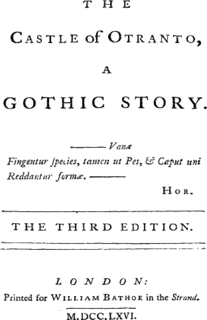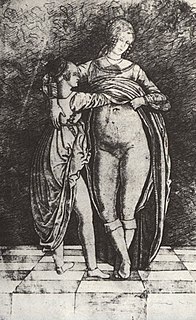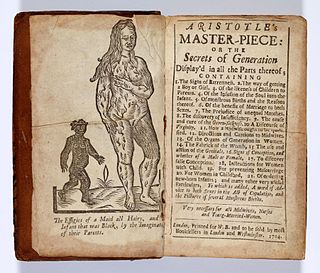Related Research Articles

Cross-dressing is the act of wearing clothes usually worn by a different gender. Cross-dressing has been used for purposes of disguise, comfort, comedy, and self-expression in modern times and throughout history.

Gothic fiction, sometimes called Gothic horror in the 20th century, is a loose literary aesthetic of fear and haunting. The name is a reference to Gothic architecture of the European Middle Ages, which was characteristic of the settings of early Gothic novels.
Slash fiction is a genre of fan fiction that focuses on romantic or sexual relationships between fictional characters of the same sex. While the term "slash" originally referred only to stories in which male characters are involved in an explicit sexual relationship as a primary plot element, it is now also used to refer to any fan story containing a romantic pairing between same-sex characters. Many fans distinguish slash with female characters as a separate genre, commonly referred to as femslash.

Tribadism or tribbing, commonly known by its scissoring position, is a lesbian sexual practice in which a woman rubs her vulva against her partner's body for sexual stimulation, especially for stimulation of the clitoris. This may involve vulva-to-vulva contact or rubbing the vulva against the partner's thigh, stomach, buttocks, arm, or other body part. A variety of sex positions are practiced, including the missionary position.

Erotic art is a broad field of the visual arts that includes any artistic work intended to evoke erotic arousal. It usually depicts human nudity or sexual activity, and has included works in various visual mediums, including drawings, engravings, films, paintings, photographs, and sculptures. Some of the earliest known works of art include erotic themes, which have recurred with varying prominence in different societies throughout history. However, it has also been widely considered taboo, with either social norms or laws restricting its creation, distribution, and possession. This is particularly the case when it is deemed pornographic, immoral, or obscene.

Erotic literature comprises fictional and factual stories and accounts of eros intended to arouse similar feelings in readers. This contrasts erotica, which focuses more specifically on sexual feelings. Other common elements are satire and social criticism. Much erotic literature features erotic art, illustrating the text.

A gynoid, or fembot, is a feminine humanoid robot. Gynoids appear widely in science fiction film and art. As more realistic humanoid robot design becomes technologically possible, they are also emerging in real-life robot design.

Lesbian erotica deals with depictions in the visual arts of lesbianism, which is the expression of female-on-female sexuality. Lesbianism has been a theme in erotic art since at least the time of ancient Rome, and many regard depictions of lesbianism to be erotic.

Lesbianism is the sexual and romantic desire between women. There are historically far fewer mentions of lesbianism than male homosexuality, due to many historical writings and records focusing primarily on men.
Whore dialogues are a literary genre of the Renaissance and the Enlightenment and a type of erotic fiction. The first example was the Ragionamenti by Pietro Aretino, followed by such works as La Retorica delle Puttane (1642) by Ferrante Pallavicino; L'Ecole des Filles (1655), attributed to Michel Millot and Jean L'Ange and also known as The School of Venus; The Dialogues of Luisa Sigea by Nicolas Chorier—known also as A Dialogue between a Married Woman and a Maid in various editions. Such works typically concerned the sexual education of a naive to less older woman by an experienced older woman and often included elements of philosophising, medical folklore, satire and anti-clericalism. The later works in this genre, such as that by Chorier, indulge in a more sophisticated type of sexual fantasy and are the precursors of the more explicit pornography which followed in Europe.

Sexual attitudes and behaviors in ancient Rome are indicated by art, literature, and inscriptions, and to a lesser extent by archaeological remains such as erotic artifacts and architecture. It has sometimes been assumed that "unlimited sexual license" was characteristic of ancient Rome. Verstraete and Provençal opine that this perspective was simply a Christian interpretation: "The sexuality of the Romans has never had good press in the West ever since the rise of Christianity. In the popular imagination and culture, it is synonymous with sexual license and abuse."

Londa Schiebinger is the John L. Hinds Professor of History of Science, Department of History, and by courtesy the d-school, Stanford University. She received her Ph.D. from Harvard University in 1984. An international authority on the theory, practice, and history of gender in science, she is currently Director of Gendered Innovations in Science, Medicine, Engineering, and Environment Project. She is an elected member of the American Academy of Arts and Sciences. Schiebinger received honorary doctorates from the Vrije Universiteit Brussel, Belgium (2013), from the Faculty of Science, Lund University, Sweden (2017), and from Universitat de València, Spain (2018). She serves on the international advisory board of Signs: Journal of Women in Culture and Society.
The Merryland books were a genre of English 17th and 18th century erotic fiction in which the female body was described in terms of a topographical metaphor derived from a pun on Maryland. Four of the titles were published by 18th century controversialist Edmund Curll.

Homosexuality in ancient Rome often differs markedly from the contemporary West. Latin lacks words that would precisely translate "homosexual" and "heterosexual". The primary dichotomy of ancient Roman sexuality was active/dominant/masculine and passive/submissive/feminine. Roman society was patriarchal, and the freeborn male citizen possessed political liberty (libertas) and the right to rule both himself and his household (familia). "Virtue" (virtus) was seen as an active quality through which a man (vir) defined himself. The conquest mentality and "cult of virility" shaped same-sex relations. Roman men were free to enjoy sex with other males without a perceived loss of masculinity or social status, as long as they took the dominant or penetrative role. Acceptable male partners were slaves and former slaves, prostitutes, and entertainers, whose lifestyle placed them in the nebulous social realm of infamia, excluded from the normal protections accorded to a citizen even if they were technically free. Although Roman men in general seem to have preferred youths between the ages of 12 and 20 as sexual partners, freeborn male minors were off limits at certain periods in Rome, though professional prostitutes and entertainers might remain sexually available well into adulthood.

The history of erotic depictions includes paintings, sculpture, photographs, dramatic arts, music and writings that show scenes of a sexual nature throughout time. They have been created by nearly every civilization, ancient and modern. Early cultures often associated the sexual act with supernatural forces and thus their religion is intertwined with such depictions. In Asian countries such as India, Nepal, Sri Lanka, Japan and China, representations of sex and erotic art have specific spiritual meanings within native religions. The ancient Greeks and Romans produced much art and decoration of an erotic nature, much of it integrated with their religious beliefs and cultural practices.

Aristotle's Masterpiece, also known as The Works of Aristotle, the Famous Philosopher, is a sex manual and a midwifery book that was popular in England from the early modern period through to the nineteenth century. It was first published in 1684 and written by an unknown author who falsely claimed to be Aristotle. As a consequence the author is now described as a Pseudo-Aristotle, the collective name for unidentified authors who masqueraded as Aristotle. Some claim that the book was banned in Britain until the 1960s, although there was no provision in the UK for "banning" books as such. However, reputable publishers and booksellers might have been cautious about selling Aristotle's Masterpiece, at least in the wake of the 1857 Obscene Publications Act.
The one-sex and two-sex theories are two models of human anatomy or fetal development discussed in Thomas Laqueur's book Making Sex: Body and Gender from the Greeks to Freud. Laqueur theorizes that a fundamental change in attitudes toward human sexual anatomy occurred in Europe in the 18th and 19th centuries. He draws from scholars such as Aristotle and Galen to argue that prior to the eighteenth century, women and men were viewed as two different forms of one essential sex: that is, women were seen to possess the same fundamental reproductive structure as men, the only difference being that female genitalia was inside the body, not outside of it. Anatomists saw the vagina as an interior penis, the labia as foreskin, the uterus as scrotum, and the ovaries as testicles. Laqueur uses the theory of interconvertible bodily fluids as evidence for the one-sex model. However, he claims that around the 18th century, the dominant view became that of two sexes directly opposite to each other. In his view, the departure from a one-sex model is largely because of political shifts which challenged the way women's sexuality came to be seen. One result of this was the emerging view of the female orgasm as nonessential to conception after the eighteenth century. Women and men began to be seen as opposites and each sex was compared in relation to the other. Freud's work further perpetuated the sexual socialization of women by dictating how they should feel pleasure.
Feminism has affected culture in many ways, and has famously been theorized in relation to culture by Angela McRobbie, Laura Mulvey and others. Timothy Laurie and Jessica Kean have argued that "one of [feminism's] most important innovations has been to seriously examine the ways women receive popular culture, given that so much pop culture is made by and for men." This is reflected in a variety of forms, including literature, music, film and other screen cultures.
Mary Cooper was an English publisher and bookseller based in London who flourished between 1743 and 1761. With Thomas Boreman, she is the earliest publisher of children's books in English, predating John Newbery.
In feminist theory, the principle of male as norm holds that language referring to females, such as the suffix -ess, the use of man to mean "human", and other such devices, strengthens the perceptions that the male category is the norm and that the corresponding female category is a derivation and thus less important. The idea was first clearly expressed by 19th-century thinkers who began deconstructing the English language to expose the products and footings of patriarchy.
References
- ↑ Harvey, Karen (2004). Reading Sex in the Eighteenth Century: Bodies and Gender in English Erotic Culture. Cambridge UP. pp. 42–43. ISBN 9780521822350 . Retrieved 26 April 2013.
- 1 2 Boucé, Paul-Gabriel (1987). "Chthonic and Pelagic Metaphorization in Eighteenth-Century English Erotica". In Robert P. Maccubin (ed.). 'Tis Nature's Fault: Unauthorized Sexuality During the Enlightenment. Cambridge UP. pp. 209–. ISBN 9780521347686 . Retrieved 26 April 2013.
- ↑ Harvey, Karen (2001). "Gender, Space and Modernity in Eighteenth-Century England: A Place Called Sex". History Workshop Journal . 51 (51): 158–79. doi:10.1093/hwj/2001.51.158. JSTOR 4289725. PMID 18770907.